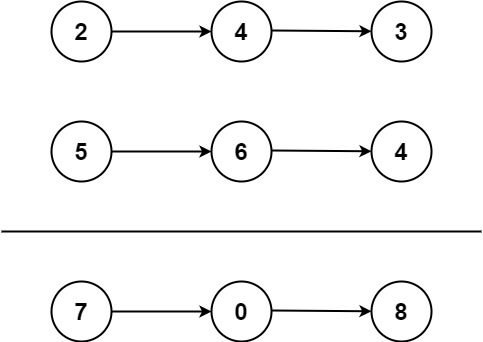LeetCode2 两数相加
题目链接:LeetCode2
描述
给你两个 非空 的链表,表示两个非负的整数。它们每位数字都是按照 逆序 的方式存储的,并且每个节点只能存储 一位 数字。
请你将两个数相加,并以相同形式返回一个表示和的链表。
你可以假设除了数字 0 之外,这两个数都不会以 0 开头。

示例
输入:l1 = [2,4,3], l2 = [5,6,4]
输出:[7,0,8]
解释:342 + 465 = 807.输入:l1 = [9,9,9,9,9,9,9], l2 = [9,9,9,9]
输出:[8,9,9,9,0,0,0,1]
思路
循环即遍历链表 l1 和 l2,每次把两个节点值 l1.val, l2.val 与进位值 carry 相加,除以 10 的余数即为当前节点需要保存的数位,除以 10 的商即为新的进位值。
代码
class Solution {
public ListNode addTwoNumbers(ListNode l1, ListNode l2) {
ListNode dummy = new ListNode(-1);
ListNode cur = dummy;
int carry = 0;
int sum = 0;
while(l1 != null || l2!=null || carry != 0){
int a = l1 == null ? 0 : l1.val;
int b = l2 == null ? 0 : l2.val;
sum = a + b + carry;
ListNode temp = new ListNode(sum%10);
carry = sum/10;
cur.next = temp;
cur = cur.next;
if(l1 != null) l1 = l1.next;
if(l2 != null) l2 = l2.next;
}
return dummy.next;
}
}